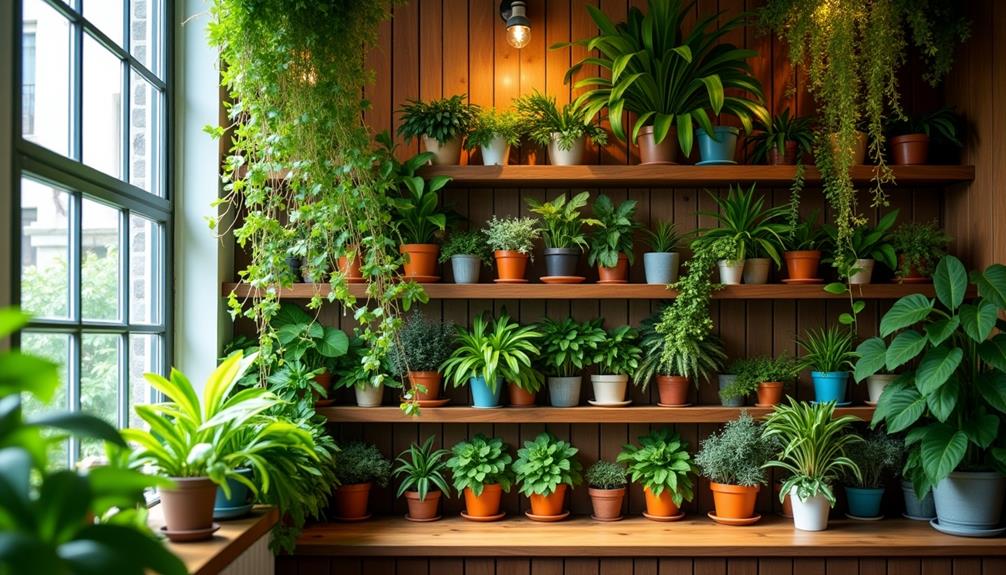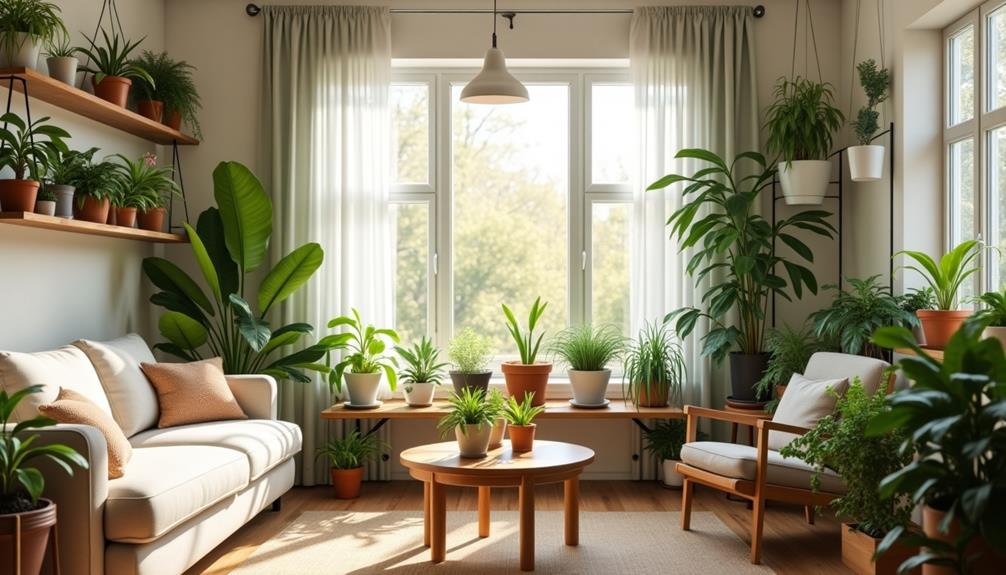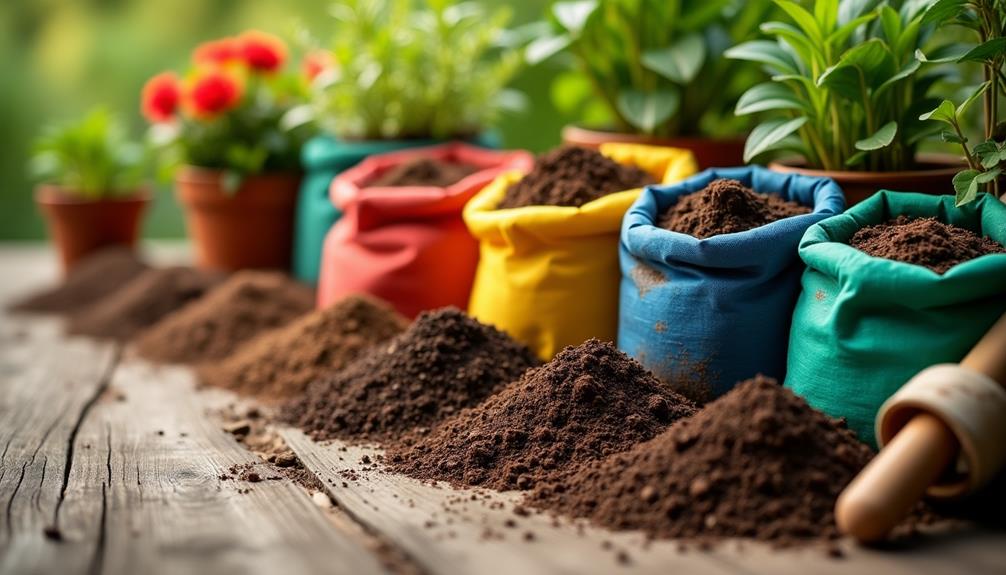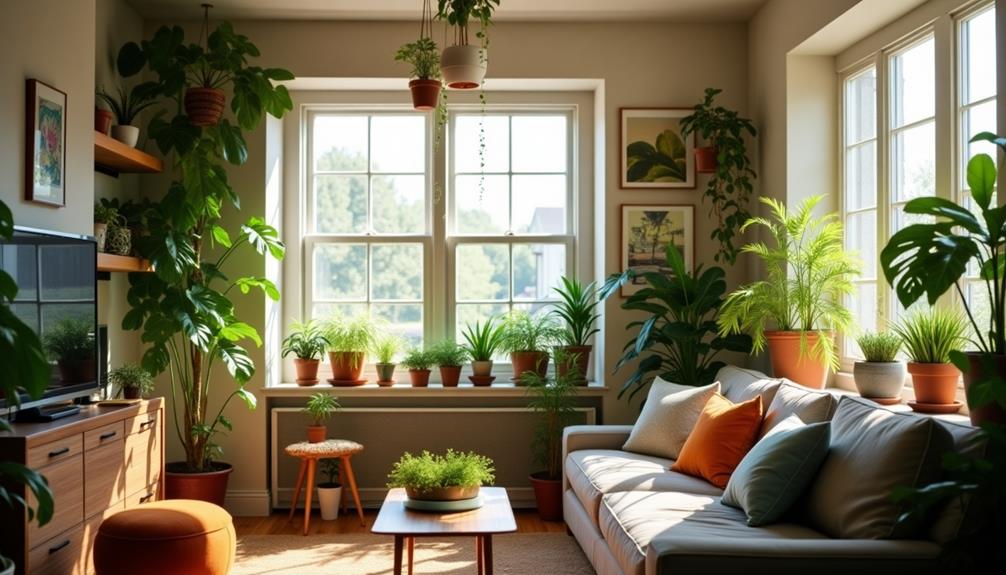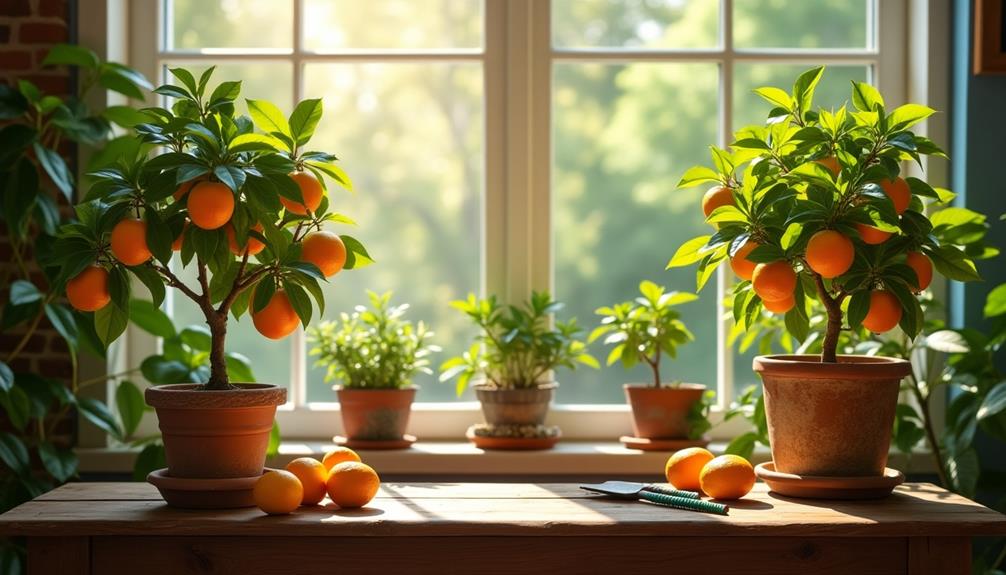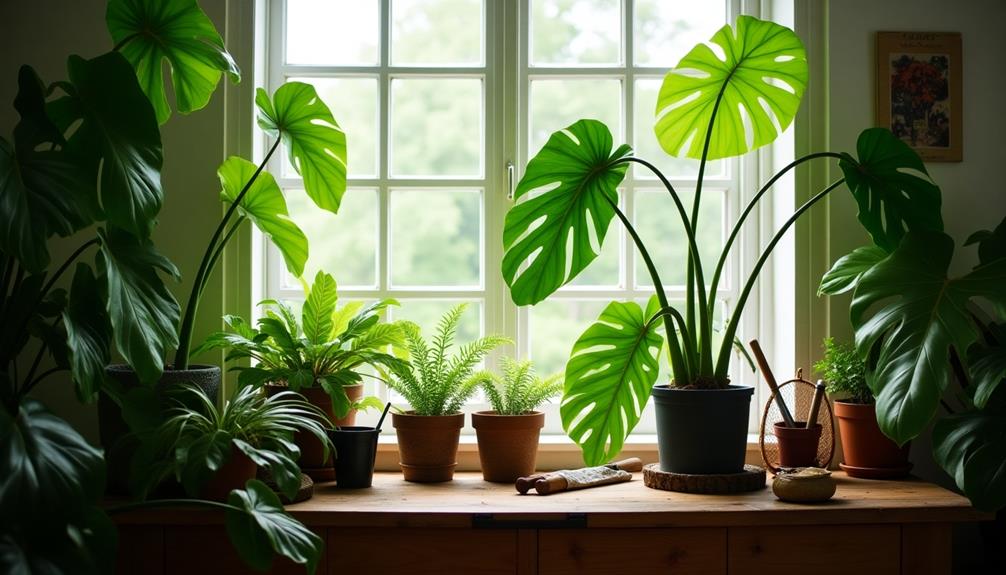You don't need a green thumb to create a stunning plant shelf wall; with the right planning, anyone can do it. First, consider how to choose the ideal location and materials that suit your style while ensuring your plants thrive. Once you've set the foundation, it's time to think about the plants themselves. What if you could transform a simple wall into a vibrant display that not only beautifies your space but also enhances your well-being? Let's explore the essential steps to bring your vision to life.
Choosing the Right Location
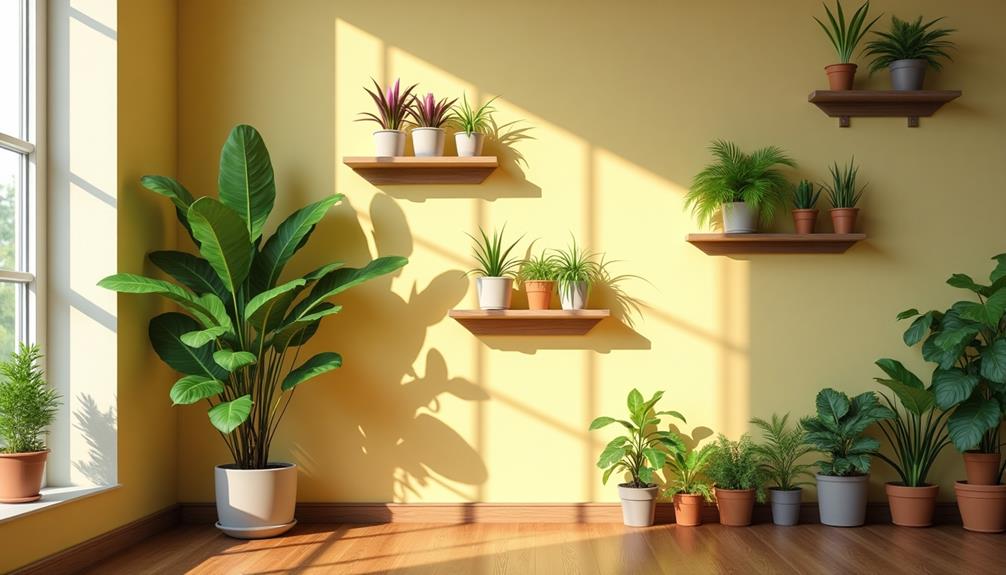
When considering where to place your plant shelf wall, how does the natural light in the room factor into your decision? The right amount of natural light is crucial for your plants' health and growth.
You'll want to position your shelf near a window or in a spot that receives adequate sunlight throughout the day. Observe how light changes in your space; morning sun can be gentle, while afternoon rays might be intense.
Additionally, pay attention to the wall condition where you plan to mount the shelf. A sturdy, clean wall is essential for securely holding your plants and pots.
Check for any dampness or peeling paint that could affect both the shelf and the plants. If your wall is in poor condition, consider a different location or make the necessary repairs before installing your shelf.
Ultimately, balancing natural light with the wall's structural integrity ensures your plant shelf wall not only looks great but also supports your plants' needs.
Selecting Your Shelving Material
After choosing the right location for your plant shelf wall, it's time to think about the material for your shelves. Start by considering the shelf weight; you'll want something that can support your plants without sagging. For this, sturdy materials like wood or metal are ideal.
Next, think about shelf height and depth; ensure they're appropriate for both your plants and the space available.
Shelf style and finish matter too. You can go for a rustic wood look or a sleek metal finish, depending on your decor. Don't forget shelf color; it should complement your room while highlighting your plants.
Now, consider shelf spacing. Make sure there's enough room between shelves to accommodate taller plants without crowding them.
For durability, choose materials that can withstand moisture, especially if you tend to overwater.
Picking the Perfect Plants
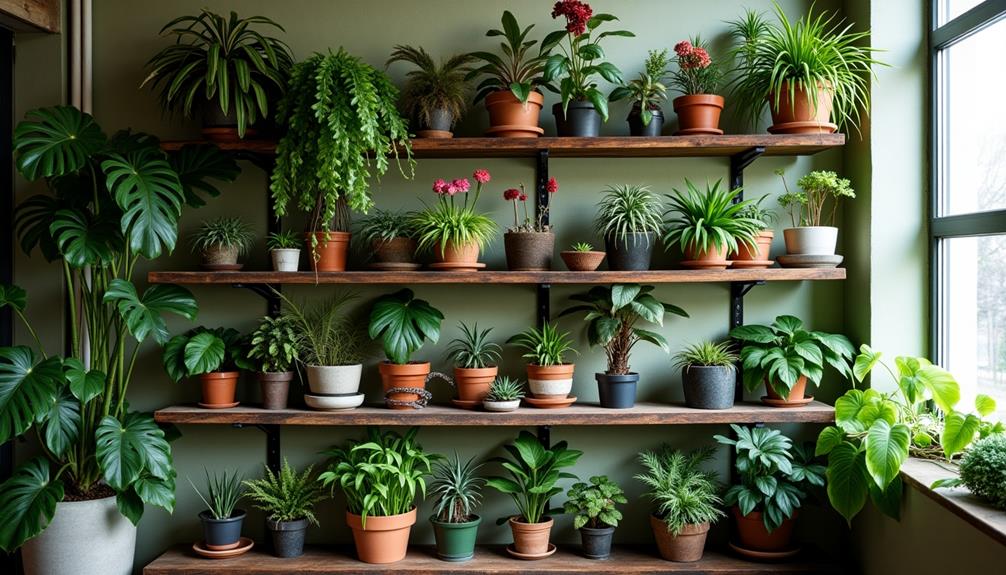
Choosing the right plants for your shelf wall can make all the difference in creating a vibrant display. Start by considering your environment—how much light does the area receive? Some plants thrive in bright, indirect light, while others can tolerate low light. Make sure to select plants that match your light conditions to ensure their health.
Next, think about the plant care requirements. Do you want low-maintenance options like succulents and snake plants, or are you ready to dive into more demanding species? It's essential to choose plants whose care aligns with your lifestyle.
Finally, pay attention to the growth habits of each plant. Some plants, like pothos, will trail beautifully over the edge of your shelves, while others, like ferns, will add a lush, bushy look.
Mixing different growth habits can create depth and interest in your display.
Designing Your Layout
With your plants selected, it's time to focus on the layout of your shelf wall. Start by considering the shelf height. You'll want to place taller plants at the bottom or on lower shelves, ensuring they don't block the light for your smaller plants.
Once you've established a base height, think about the arrangement.
Next, think about plant spacing. You don't want your plants too close together, as this can lead to overcrowding and competition for light. Aim for a mix of spacing that allows air circulation while still creating a visually appealing look.
Group plants with similar care requirements together to simplify maintenance.
Consider the colors and textures of your plants as well. A good layout balances various shades of green and different leaf shapes to create an eye-catching display.
Tools and Supplies Needed
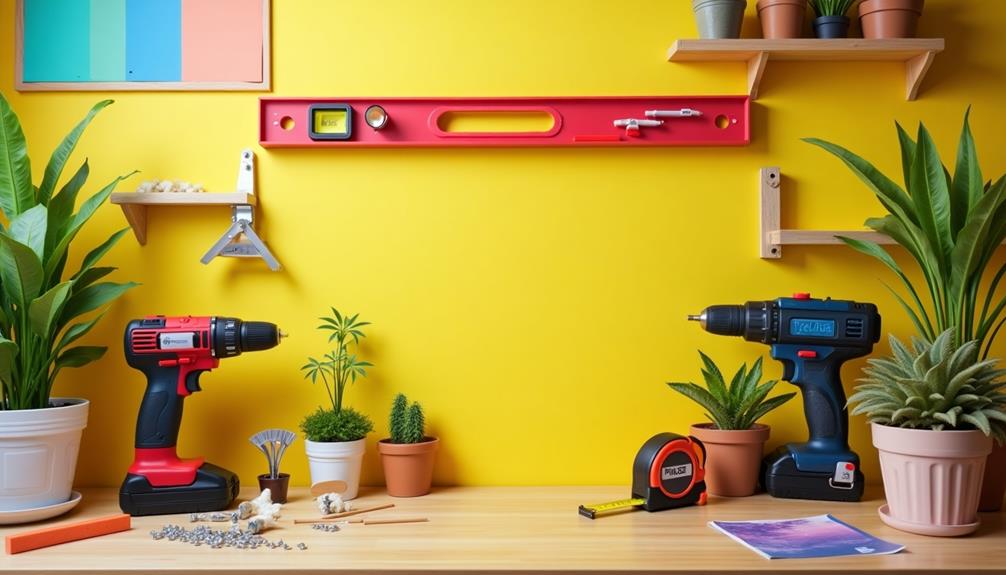
Before you start building your plant shelf wall, you'll need to gather some essential tools and materials.
Make sure you have everything on hand to ensure a smooth setup process.
Let's go over what you'll need to create a sturdy and stylish display for your plants.
Essential Tools Required
Creating a plant shelf wall often requires a few essential tools and supplies to ensure a successful project.
First, you'll need a tape measure to determine the optimal shelf height for your plants, ensuring they're easily accessible and well-displayed. A level is also crucial; it'll help you keep your shelves straight and aligned, preventing any tilting that could affect your plants' stability.
You'll want a drill and the appropriate drill bits for securely mounting the shelves to the wall.
Don't forget the anchors or brackets, as they'll provide the necessary support for your shelf structure. A stud finder is handy, too, as it'll help you locate the best spots to attach your shelves to the wall, ensuring they can hold the weight of your plants.
Recommended Plant Shelving Materials
When planning your plant shelf wall, selecting the right materials is key to ensuring durability and aesthetics. Start with sturdy shelving boards made from hardwood, plywood, or metal. These materials provide excellent shelf durability and can handle various plant weights without sagging or bending over time.
Next, consider brackets. Heavy-duty brackets are essential for supporting your shelves. Look for options made from steel or wrought iron, as they can bear significant loads while adding a stylish touch to your design.
Don't forget to check the weight capacity of both the shelves and brackets to ensure they align with your plant weight requirements.
For finishes, a good quality sealant or paint can protect your wood from moisture and enhance its appearance. If you're going for a rustic look, untreated wood can be charming, but remember it may require more maintenance.
Installing Your Shelves
How do you ensure your plant shelf wall is sturdy and visually appealing? First, you'll want to determine the appropriate shelf height based on the types of plants you plan to display. Consider how tall your plants will grow and adjust the height accordingly. This consideration helps you maximize both aesthetics and functionality.
Next, use a stud finder to locate the wall studs, as this will enhance wall stability. Mark these spots, ensuring you space your shelves evenly. If you're using brackets, make sure they're rated to support the weight of your plants and pots.
Drill pilot holes into the studs for a secure fit, and use wall anchors if you're mounting shelves on drywall without studs. After installing the brackets, place your shelves on top and double-check that everything is level.
Tighten all screws and ensure each shelf feels secure before placing any plants on them. Remember, the stability of your shelf wall is crucial, especially as your plants grow and gain weight. This preparation won't only keep your plant shelf wall safe but will also create an inviting space for your green companions.
Arranging Plants Aesthetically
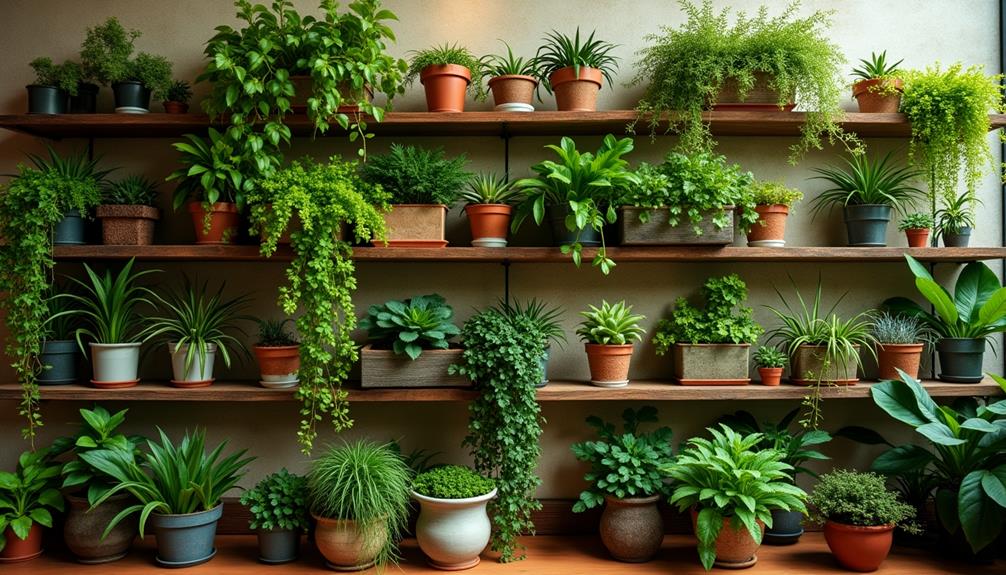
Start by visualizing your plant shelf wall as a dynamic display that reflects your personal style. To achieve this, consider color theory—pair plants with complementary hues to create a striking visual impact.
Think about plant harmony; choose species that not only thrive together but also enhance each other's beauty. Incorporating texture contrast can add depth; mix leafy ferns with spiky succulents for a captivating arrangement.
Embrace height variations to draw the eye upward, creating a sense of movement. Use taller plants like snake plants as focal points, while smaller ones can fill in gaps.
Light considerations are crucial; position light-loving plants at the top where they can soak it up, and place shade-tolerant varieties lower down.
Experiment with seasonal arrangements, swapping out plants as the seasons change to keep your display fresh.
Also, don't forget about plant shapes—circular leaves can soften sharp angles, while upright forms can lend structure. Aim for visual balance; distribute plants evenly across your shelves, ensuring no area feels too heavy or sparse.
With these tips, you'll create a stunning plant shelf wall that showcases your unique style beautifully.
Maintaining Your Plant Shelf
Maintaining your plant shelf requires regular attention to keep your green oasis thriving. Start by establishing a watering schedule that suits each plant's needs. Some may need daily watering, while others thrive with less frequent moisture. Monitor humidity levels, especially for tropical plants, ensuring they've the right environment to flourish.
Next, pay attention to light requirements. Rotate your plants regularly to ensure all sides receive adequate sunlight, promoting even growth.
Seasonal care is also crucial; adjust your care routine as seasons change, as light and temperature can vary significantly.
For pest management, inspect your plants weekly. Early detection of pests is key to preventing infestations. Keep an eye on plant health by checking for yellowing leaves or unusual spots, indicating stress or disease.
Don't forget about fertilization tips. Feed your plants during their active growth period, typically spring and summer, to encourage robust growth.
Lastly, perform regular shelf maintenance, cleaning dust off leaves and rearranging plants if they outgrow their spots. With diligent growth monitoring, your plant shelf will remain a vibrant, healthy haven.
Personalizing Your Display
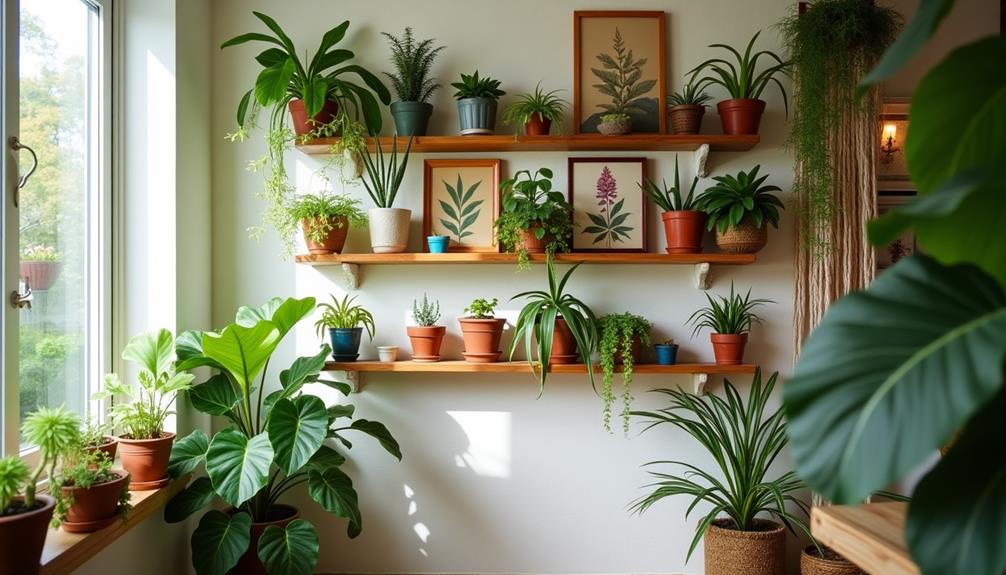
To make your plant shelf wall truly yours, start by choosing your favorite plants that resonate with your style.
Incorporate decorative elements like unique pots or personal trinkets to enhance the visual appeal.
This combination will create a display that's not only vibrant but also reflects your personality.
Choosing Your Favorite Plants
Choosing the right plants for your shelf wall can transform it into a personalized oasis that reflects your style. Start by considering your space and the light requirements of your chosen plants. Do you have a bright, sunny spot or a more shaded area? Succulents and cacti thrive in high light, while ferns and snake plants can tolerate lower light conditions.
Next, think about your commitment to plant care. Some plants, like pothos and ZZ plants, are low-maintenance and perfect for beginners, while others, like orchids, require more attention and specific care. Assess how much time you can dedicate to watering, pruning, and repotting.
Once you know your light conditions and care preferences, it's time to select plants that resonate with you. Whether you prefer lush greenery or striking blooms, make sure to choose varieties that bring you joy.
Mix in different textures and heights to create visual interest on your shelf wall. Remember, your plant choice should create harmony in your space while showcasing your unique personality. Embrace the process and let your plant shelf wall reflect who you are!
Adding Decorative Elements
Personalization is key when it comes to adding decorative elements to your plant shelf wall. Start with shelf styling by integrating decorative accents that reflect your personality. Think about plant accessories like unique pots, stands, or hangers that enhance your favorite plants.
Next, focus on color coordination. Choose a palette that complements your plants and other decor to create a harmonious look. Mixing textures can also add depth; consider smooth ceramics alongside rustic wood or metallic elements. This variety can elevate your display significantly.
Incorporate seasonal decorations to keep your shelf dynamic. Think about festive touches during holidays or seasonal changes that resonate with your style.
For a more curated approach, create artistic arrangements that draw the eye, grouping plants and decorative elements in odd numbers or varying heights for visual interest.

